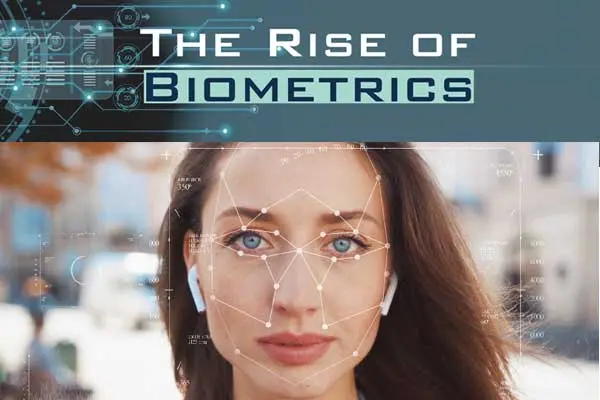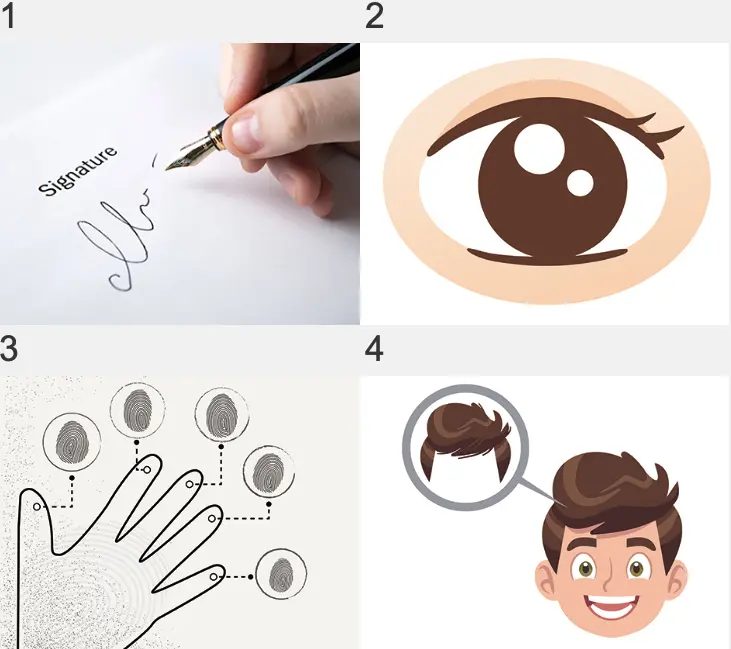
生物辨識: 以個人特徵辨認身分 The Rise of Biometrics
The Rise of Biometrics
#閱讀測驗
9/22 解析英語
作者 Niall Longobardi
閱讀時間 10分鐘
聽講解 聽朗讀
本圖文出處:
https://www.ivy.com.tw/newsLetter/an...051714064350824MP3:
MP3:生物辨識: 以個人特徵辨認身分 The Rise of Biometrics
隨著科技越來越融入在我們的日常生活中,新形式也不 斷出現。
目錄 / More to Learn / Grammar Tips / 中文翻譯(& 答案)
閱讀測驗
As technology becomes increasingly ingrained in our daily lives, new forms continue to emerge all the time. One novel example that you might have heard about is biometrics. This technology is defined as a means of identifying and authenticating a person using biological characteristics. Common biometric types include fingerprint mapping, facial recognition, and retina scans. Biometrics can be used to either authenticate a person’s identity or identify individuals. Biometric authentication involves comparing a person’s data with their previously stored information. In contrast, biometric identification involves comparing a person’s data to that of others in a database to determine their identity.
Biometrics can be classified into two categories: physiological measurements and behavioral measurements. Physiological measurements can be further divided into two sets. Morphological identifiers refer to physical characteristics unique to an individual and that are unlikely to change, including fingerprints and eyes. For a biological analysis, DNA, blood, or urine samples are used. Contrary to physiological measurements, behavioral measurements look at a person’s actions, such as how they talk, walk, and even sign their name.
While biometrics might seem like a new, cutting-edge technology, it has actually been used for over 100 years. Around the turn of the 20th century, police forces in cities like London and Paris began using fingerprints to identify criminals. Law enforcement remains one of the most common fields where biometrics is employed. This includes using advanced technology like Automatic Biometric Identification Systems that can find criminals based on photos. Biometrics has also become widely used for immigration and border control. Many airports now have passengers scan their faces and fingertips upon entry and exit.
While advancements in biometrics can be helpful, there are still concerns. Not all biometric tests are 100% accurate, and some facial recognition programs have been known to misidentify people of color more frequently. Hopefully, as this technology further develops, it will be used in ways that prioritize beneficial applications for society.
1.According to the passage, how does biometric authentication differ from biometric identification?
(A) Biometric identification mainly uses morphological identifiers.
(B) Biometric identification is only used for immigration and border control.
(C) Biometric authentication compares a person’s information to that of other people.
(D) Biometric authentication compares a person’s information to what they previously stored.
2.Which two of the following are NOT morphological identifiers?

(A) 1 & 4. (B) 1 & 3. (C) 2 & 3. (D) 2 & 4.
3. According to the passage, in what way are airports using biometrics?
(A) They are using fingerprints to give people their tickets.
(B) Eye scans are taking place at domestic security checkpoints.
(C) Faces and fingertips are scanned to record who leaves or enters a country.
(D) Automatic Biometric Identification Systems are being used to find criminals at airports.
4. Which aspect of biometrics is NOT discussed in the passage?
(A) Worries about its accuracy.
(B) Examples of how it is used.
(C) Different types of it.
(D) Costs of utilizing it.
答案: 1.D 2.A 3.C 4.D
單字片語整理
Words in Use
●
compare [kəmˋpɛr]
vi. (可與……)匹敵
vt. 把……比作
vt. & vi. 比較
●
identify [aɪˋdɛntə͵faɪ]
vt. 指認,認定;視為同一
vi. 對……感同身受(與介詞 with 並用)
●
identification [aɪ͵dɛntəfəˋkeʃən]
n. 身分證明(不可數,縮寫為 ID)
●
characteristic [͵kærəktəˋrɪstɪk]
a. 典型的(皆與介詞 of 並用)
n. 特徵
●
enforcement [ɪnˋforsmənt]
n. 實施,執行
●
immigration [͵ɪməˋgreʃən]
n. 移居(由外移入)
●
beneficial [͵bɛnəˋfɪʃəl]
a. 有益的
●
analysis [əˋnæləsɪs]
n. 分析
●
emerge [ɪˋmɝdʒ]
vi. 出現,冒出(常與介詞 from 並用)
●
automatic [͵ɔtəˋmætɪk]
a. 自動的
●
database [ˋdetə͵bes]
n. 資料庫
●
prioritize [praɪˋɔrə͵taɪz]
vt. 視⋯⋯為第一優先
●
urine [ˋjʊrɪn]
n. (正式用法) pee
●
advancement [ədˋvænsmənt]
n. 發展,改善
●
cutting-edge [ˌkʌtɪŋˈɛdʒ]
a. 尖端的,最新的
●
ingrained [ɪnˋgrend]
a. 根深蒂固的
●
physiological [͵fɪzɪəˋlɑdʒɪk!]
a. 生理(學)的
●
behavioral [bɪˋhevjərəl]
a. 行為的
●
analyses [əˋnæləsɪz]
n. 分析(複數形)
●
authenticate [ɔˋθɛntɪ͵ket]
vt. 證實
●
authentication [ɔ͵θɛntɪˋkeʃən]
n. 證實
●
morphological [͵mɔrfəˋlɑdʒəkəl]
a. 形態的
●
identifier [aɪˋdɛntə͵faɪɚ]
n. 識別符號
●
fingertip [ˋfɪŋgɚ͵tɪp]
n. 指尖
Practical Phrases
●
be unique to + 地方 為某地方所獨有
= be native to + 地方
= be indigenous to + 地方
Kiwi birds are unique to New Zealand. Nowhere else can you find them.
鷸鴕為紐西蘭所獨有,其他地方都找不到。
●
compare A to B 把 A 比喻為 B
Life is often compared to a long journey.
人生常被比喻為一段漫長的旅程。
●
be classified into 被區分為 A 和 B
●
be beneficial to / for... 對......有益
Exercising on a daily basis is beneficial to your health.
每天運動對你的健康有好處。
●
compare A with B 將 A 與 B 作比較
Some parents like to compare their kids with other kids.
有些父母喜歡拿他們的孩子和別人的孩子作比較。
●
contrary to... 與⋯⋯相反(的是)
Contrary to popular belief, that country is filled with beautiful landscapes.
和一般認知不同的是,那個國家到處都是美景。
●
in contrast 相對地,相較之下
Sarah is usually quiet. In contrast, her brother is always noisy.
莎拉通常很安靜。相較之下,她弟弟一向很吵。
●
be divided into 被分成⋯⋯
●
the turn of the + 序數詞 + century 在某世紀交替之時
More to Learn
biometrics [ ͵baɪəˋmɛtrɪks ] n. 生物辨識
• With biometrics, you can unlock your smartphone by simply scanning your face or fingerprint.
有了生物辨識,你可以簡單地掃描臉部或指紋來解鎖你的智慧型手機。
字首 bio- 表「生物」,以下介紹常見單字:
a. biological [ ͵baɪəˋlɑdʒɪk! ] a. 生物學的
• We all have a biological clock that tells us when to sleep and wake up.
我們都有一個生理時鐘告訴我們何時該睡覺和起床。
b. biology [ baɪˋɑlədʒɪ ] n. 生物(學)
• My mother’s love for gardening fostered my interest in biology.
我媽媽對園藝的喜好培養了我對生物學的興趣。
c. biofuel [ ˈbaɪəʊfjʊəl ] n. 生質燃料
biodiesel [ ˈbaɪəʊˌdiːzl ] n. 生質柴油(由植物油或動物脂肪製成的燃料)
• Biofuels are fuels made from plants or animals.
生質燃料是用植物或動物製成的燃料。
d. biodiversity [ baɪo͵daɪˋvɝsətɪ ] n. 生物多樣性
• Madagascar is famous for its biodiversity.
馬達加斯加以其生物多樣性聞名。
e. biodegradable [ ˋbaɪodɪˋgredəb! ] a. 能進行生物分解的
• Some plastic bags are biodegradable.
有些塑膠袋能進行生物分解。
Grammar Tips
Many airports now have passengers scan their faces and fingertips upon entry and exit.
have 當使役動詞時,有下列三種用法:
※ have 表「叫(某人做某事)」,可用 make 代替,其後加受詞,再以原形動詞作補語(本文即為此用法), 形成下列句型:
have + 受詞(通常為人)+ 原形動詞
叫⋯⋯(某人)做⋯⋯
= make + 受詞 + 原形動詞
= get + 受詞 + to + 原形動詞
• Elaine had / made her son fix her phone.
= Elaine got her son to fix her phone.
伊蓮叫兒子修她的手機。
※ have 亦可表「把(某物)⋯⋯」,可用 get 代替,此時則以過去分詞作受詞補語,形成下列句型:
have + 受詞 + 過去分詞
把⋯⋯(被)⋯⋯(常指請他人代勞,而非親自做)
= get + 受詞 + 過去分詞
• Andy had / got his car washed over the weekend.
安迪在週末的時候讓人把他的車洗好了。
※ have 加受詞後,其後亦可接現在分詞作受詞補語,強 調動作自然發生或持續進行。句型如下:
have + 受詞 + 現在分詞 使/讓⋯⋯一直(做)⋯⋯
• The singer’s performance had her fans screaming and jumping in the arena.
那名歌手的表演讓她的粉絲在會場裡又叫又跳。
精選試題
Ken had one of his teeth _____ last Thursday.
(A) pull (B) pulled (C) pulling (D) be pulled
答案:B
中文翻譯(& 答案)
隨著科技越來越融入在我們的日常生活中,新形式也不 斷出現。一個你可能曾聽過的新穎例子就是生物辨識技術。 這種技術被定義為使用生物特徵來辨識和驗證一個人的方 法。常見的生物辨識類型包括指紋映射、臉部辨識和視網膜 掃描。生物辨識可以用來驗證一個人的身分,也可以用來辨 別人。生物辨識驗證包含將一個人的資料與其先前儲存的資 料進行比對。相較之下,生物辨識識別則是將一個人的資料 與資料庫中其他人的資料進行比較,以確定其身分。
生物辨識可以分為兩類:生理測量和行為測量。生理 測量可以進一步分為兩組。型態識別符是指每個人獨特的身 體特徵,且不太可能改變的,包括指紋和眼睛。在生物分析 中,則使用 DNA、血液或尿液樣本。與生理測量相反,行 為測量看的是一個人的行為,例如他們如何說話、走路,甚 至是簽名。
雖然生物辨識或許看起來像是一種新的尖端技術,但實 際上它已經被使用了一百多年。在二十世紀之交左右,倫敦 和巴黎等城市的警察開始使用指紋識別罪犯。執法部門仍然 是最常使用生物辨識技術的領域之一。這包含使用能夠利用 照片來尋找罪犯的先進技術(如自動生物辨識識別系統)。 生物辨識也已廣泛用於移民和邊境管制。現在,許多機場都 要求乘客出入境時掃描他們的臉部和指尖。
儘管在生物辨識技術上的進步可能有所幫助,但仍然存 在一些問題。並非所有生物辨識測試都是 100% 準確的,而 且有些臉部辨識程式已知在有色人種的辨識上時常出錯。希 望隨著這項技術的進一步發展,它能夠優先以對社會有用的 方式被應用。
1. 根據本文,生物辨識驗證和生物辨識識別有何不同?
(A) 生物辨識識別主要使用型態識別符。
(B) 生物辨識識別只用於移民和邊境管制。
(C) 生物辨識驗證將某人的資訊與他人的資訊比對。
(D) 生物辨識驗證將某人的資訊與其之前儲存的資訊作比對。
2. 下列哪兩者不是型態識別符?
(A) 1 & 4.
(B) 1 & 3.
(C) 2 & 3.
(D) 2 & 4.
3. 根據本文,機場是如何使用生物辨識的?
(A) 他們使用指紋來給人們機票。
(B) 眼睛掃描在每個國內安檢點都有在執行。
(C) 掃描臉部和指尖來記錄出入境的人。
(D) 自動生物辨識識別系統在機場被用來尋找罪犯。
4. 本文並未討論到生物辨識的哪一個面向?
(A) 對其準確性的擔憂。
(B) 其如何使用的例子。
(C) 不同種類的生物辨識。
(D) 使用生物辨識的成本。












